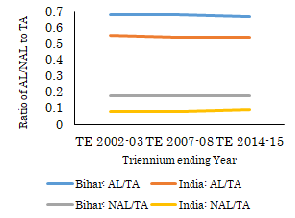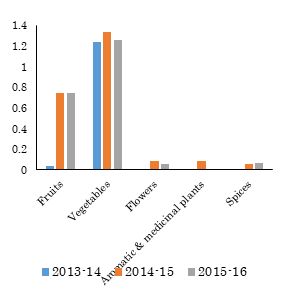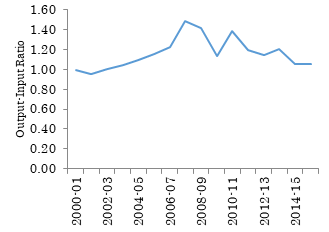Out of the seven-year period set for doubling of farmers’ income by the government, four full agricultural years have already gone. This article identifies the binding constraints on farmers’ income or economic activity in Bihar. It finds that the poor functioning of agricultural markets, reflected in the instability in the prices of agricultural produces and the low level of crop diversification, are the reasons for slow agricultural growth.
Of late, a lot has been said about the National Democratic Alliance (NDA) government’s strategy towards doubling farmers’ income and the subsequent recommendations by a specially constituted committee on it. Unlike in the past, the core theme of this round of policy recommendations has been to consider farmers’ income as the fulcrum of strategy. The reports of the Committee on Doubling of Farmers' Income under the chairmanship of Dr. Ashok Dalwai, have laid out multiple recommendations for achieving the goal of doubling farmers’ incomes by 2022.
However, it must be noted that most of these recommendations are the outcome of a top-down approach at the Union level, even though many of these policy decisions need to be undertaken by state governments. Moreover, only some of these recommendations pertain to particular states and these are to be identified after examination at the ground level, which was not undertaken in the Committee’s deliberations. Out of the seven-year period set for doubling of farmers’ income, four full agricultural years have already gone. There is, therefore, a daunting task ahead. Finally, even though the Committee reports provide estimates of the investment required to double farmers’ income by states, no attempt has been made to sequence investment needs. After all, given the fund constraints for investment and time limitation, the top priority should have been to identify the most binding constraints for increasing farmers’ income state-wise and to allocate funds accordingly.
In this context, the objective of this article is to identify the binding constraints on farmers’ income or economic activity in Bihar subject to its natural, political, and institutional settings. It is our contention that a better understanding of these constraints would help to devise appropriate policy for efficient allocation of scarce financial resources.
To identify the binding constraints and hence policy priorities for boosting agricultural growth in Bihar, in recent research (Pohit et al. 2019), we have used the growth diagnostics framework pioneered by Hausmann et al. (2008), developing a hybrid by combining it with the work of Minot et al. (2006). This framework explores a hierarchy of distortions conceptualised as a decision tree, and recommends removing the binding constraint, both on the output and the input sides, which is expected to have the largest direct effect on farmers’ income or welfare. For instance, if the problem seems to be the low scale of farming, is that due to poor soil quality, inadequate irrigation, expensive labour, or government restrictions on specific cropping patterns? Is the low scale of farming due to insecure land tenure, fragmented landholdings, high rent, or restrictions on land leasing? Of course, while data analysis drives the answers to many of these questions, this is not an easy task and requires deep insights from knowledgeable experts who know Bihar agriculture well.
Low agricultural growth
Our analysis shows that Bihar’s agricultural growth, at 2.04%, was lower than the all-India average growth of 3.12% during 2001-02 to 2016-17. This happened despite a stable political environment, improvement in investment on rural infrastructure, and reforms in agricultural marketing. In order to understand the low-growth syndrome, we have undertaken a growth diagnostics analysis on the revenue and the cost side to identify the factors that could influence both farm income and input costs associated with the pattern of inputs use.
On the revenue side, the growth in farm output is determined by four factors, namely, the area effect, yield effect, price effect, and diversification effect. The question naturally arises as to which of these best explains the low growth in agriculture.
Figure 1 indicates that the ratio of non-agricultural land to the total land area remained constant in Bihar. Albeit, the area under agricultural land declined marginally during recent years, but the land use patterns in Bihar are not dissimilar to the broader trend observed at the national level. Further, an analysis of sources of output growth showed that the overall area effect was negative and there was significant variation across the crops. In the case of a few cereals such as wheat, maize, and barley; and pulses, sugarcane, and vegetables, the area expansion contributed only marginally to the output growth. With near stagnation or fall in the net sown area, the area gain for these crops occurred through the re-allocation of existing land by the farmers. There is no scope for further expansion of cultivated land and it cannot be the source of low agricultural growth. Therefore, it is clear that agricultural land is unlikely to be a causal factor for the poor performance of agriculture in Bihar.
Figure 1. Ratio of agricultural land (AL) and non-agricultural land (NAL) in the total reported area (TA)
Can low yield of major crops be the reason for lower agricultural growth in the state? A comparison of the actual yield of major crops in Bihar with crop yield at the national level indicates that the yield of major crops under consideration shows an increasing trend over time (Table 1). The yields of rice and wheat in Bihar were slightly lower than their corresponding yields at the national level. However, with a trend growth of about 4.40% in rice and 1.77% in wheat during the period 2000-01 to 2016-17, the yields of these crops are certainly expected to surpass the national average in the short run. The yields of other crops such as maize, green gram, lentil, rapeseed, and mustard in Bihar were well above the average yields obtained at the national level. Such evidence further establishes that there is an improvement in the crop yield over time and hence low yield cannot be the reason for poor agricultural growth.
Table 1. Yields of major crops in Bihar and India (tonne/hectare (ha))
|
Particulars |
Bihar |
India |
||||
|---|---|---|---|---|---|---|
|
TE 2002-03 |
TE 2007-08 |
TE 2016-17 |
TE 2002-03 |
TE 2007-08 |
TE 2016-17 |
|
| Rice | 1.46 | 1.27 | 2.17 | 1.91 | 2.15 | 2.4 |
| Wheat | 2.04 | 1.86 | 2.17 | 2.69 | 2.71 | 2.92 |
| Maize | 2.38 | 2.35 | 3.54 | 1.83 | 2.06 | 2.61 |
| Green Gram | 0.59 | 0.59 | 0.62 | 0.33 | 0.35 | 0.46 |
| Lentil | 0.88 | 0.73 | 0.95 | 0.64 | 0.62 | 0.74 |
| Rapeseed and Mustard | 0.8 | 0.97 | 1.11 | 0.93 | 1.07 | 1.14 |
The prevailing market prices of different agricultural commodities provide signals to farmers to make decisions on area allocation, type of crops to be grown, and investment on technology, among other factors. Agricultural markets have long been regulated and controlled by the government-run Agricultural Produce Market Committees (APMCs). These committees fall under the purview of the state government. In order to strengthen competition in agricultural markets and ensure better prices for farmers through legislative measures, the Government of Bihar took a decision to repeal the APMC Act itself in 2006. As a result, traders are now allowed to purchase agricultural commodities directly from the farmers and the market fee is not levied on purchases.
Did these reforms improve price efficiency in agricultural markets of Bihar? One would expect that post the abolition of the APMC Act, the grain markets in Bihar would be integrated both within the state of Bihar and also with the national markets. This would imply an effective price transmission between the grain markets within the state and hence better prices received by farmers. Further, this would also imply low volatility of grain prices with better flow of information about the supply and demand conditions across the markets.
The data in Table 2 indicates that the average prices of major crops such as paddy, wheat, and maize increased during the post-market reforms period as compared to the pre-reform period. The average price of paddy increased by 126%, of wheat by 66%, and of maize by 81%. However, the volatility in grain prices too increased. Although the average price received by the farmers increased over time, an increase in the volatility of prices affects the stability of farmers’ income. Instability in the prices of agricultural produce also affects the farmers’ decisions to allocate the area under different crops and adopt improved cultivation practices. Therefore, instability in the prices of agricultural commodities could be a reason for lower agricultural growth in Bihar.
Table 2. Average wholesale price before and after the repeal of the APMC Act
|
Commodity |
Before Repeal (2002-06) |
After Repeal (2007-16) |
||
|---|---|---|---|---|
|
Average Price (Rs./tonne) |
Coefficient of Variation (%) |
Average Price (Rs./tonne) |
Coefficient of Variation (%) |
|
| Paddy | 511 | 11 | 1154 | 27.7 |
| Wheat | 771 | 12.2 | 1279 | 14.1 |
| Maize | 600 | 11.2 | 1084 | 24.9 |
Source: Computed from agmarknet.gov.in, Government of India.
Note: The coefficient of variation (CV) shows the extent of variability in relation to the mean of the population.
Crop diversification is another important element contributing to output growth. Given the fixed amount of land, farmers diversify cropping patterns for various reasons, including the market demand for certain commodities, augmenting farm incomes, price risk mitigation mechanisms, and enriching soil fertility. Evidence shows that the per capita consumption of cereals has declined, while the consumption of fruits, vegetables, and animal-based products has increased over time. However, the following two factors are most important with regard to the farmers’ decision to diversify: (a) the relative profitability of different crops, and (b) the availability of secure marketing arrangements.
Can the low level of crop diversification be the reason for low output growth in Bihar? An analysis of the sources of output growth showed that crop diversification contributed over a quarter of the output growth in the past one-and-a-half decade. Importantly, the effect of crop diversification on output growth has improved considerably during the recent years. However, an assessment of the relative share of the crop area suggests that the level of crop diversification is very low. In fact, just three crops, namely, paddy, wheat, and maize dominate the cropping pattern, accounting for about 80% per cent of total cropped area during 2016-17. The cultivated area under fruits and vegetables was only about 6.0% of the total, but their contribution to agricultural output was 42%.
Is there scope for the state of Bihar to achieve greater diversification towards high-value horticultural crops? Among others, the degree of crop diversification is determined by the level of productivity and market linkages. Interestingly, land productivity is much higher for horticultural crops than field crops. For instance, the land productivity was as high as Rs. 113,205/ha for dry chilies, while among cereals, it was the maximum at Rs. 37,925/ha for maize.
In order to assess the comparative advantage of growing horticultural crops in the state of Bihar, an index of relative importance has been developed. This comparative advantage index is defined as the ratio of the share of area of a crop in Bihar to the share of area of that particular crop in the country as a whole. The total horticultural area was used as the base value for working out the share. The index value of greater than one for a particular crop/group indicates a comparative advantage in growing of that crop in Bihar.
Figure 2 points to Bihar’s very high relative advantage for growing vegetables. The value of the comparative advantage index for vegetables improved between 2013-14 and 2014-15, and then slightly decelerated in 2015-16. Even though Bihar has rich alluvial soil, groundwater, and favourable climatic conditions, the relative importance of horticulture, particularly vegetables, is found to be low. Therefore, a low level of crop diversification can be another reason for poor agricultural growth in Bihar.
Figure 2: Comparative advantage in growing of horticultural crops in Bihar
An important feature of the Minot-Hausmann Hybrid framework is that it takes into account the input side of the total revenue. This is important because farmers maximise their incomes by either enhancing value of output or reducing the cost of inputs. The expenses on inputs can be reduced through various measures, including using only the required quantity of inputs on a soil test basis, timely application, proper method of application, and effective bargaining in the input markets.
Can the rising input costs be the reason for lower output growth in Bihar? An increase in the cost of inputs leads to a reduction in the profitability of crop cultivation, which, in turn, affects the decision of the farmers to make investments on productivity-enhancing inputs, such as, irrigation, improved seeds, and fertilisers.
However, the aggregate output-to-inputs ratio reveals that the value of output was much higher than the total input costs (Figure 3). The ratio of the value of output over inputs showed an increasing trend till 2007-08 and thereafter it started fluctuating while showing a declining trend. The ratio remained above one, indicating that the proportionate increase in output was higher than the total inputs, though it had weakened during the recent years. This also points to a decline in profitability in crop cultivation.
Figure 3. Ratio of gross value of output to total input costs
The use of purchased inputs in the cultivation of crops has increased over time. Having access to adequate irrigation, farmers apply external inputs such as fertilisers and pesticides to attain higher yield. The ruling crop varieties are, in fact, responsive to the application of these inputs for producing their potential yield. However, analysis shows that the prices of paddy and wheat were higher than the price of fertiliser. Further, input intensification in the agriculture sector in Bihar is estimated to be low. This evidence shows that rising input costs cannot be the reason for lower agricultural growth in Bihar.
It is clear from the above discussion that the poor functioning of agricultural markets, reflected in the instability in the prices of agricultural produces and the low level of crop diversification, are found to be the reasons for slow or lower agricultural growth in Bihar. It is important to understand why the state of Bihar faces constraints with regard to its agricultural markets and crop diversification.
Concomitantly, therefore, relaxing the constraints on agricultural markets and promoting the drive towards crop diversification would lead to higher agricultural growth in Bihar. Below is a summary of the reasons for the binding constraints pertaining to these two factors.
Identifying binding constraints on agricultural markets
Despite the abolition of the APMC Act in 2006, private investment in the creation of new markets and strengthening of facilities in the existing ones did not take place, leading to low market density. Further, participation of government agencies in the procurement and scale of procurement of grains continues to be low. Thus, farmers are left to the mercy of traders who unscrupulously fix lower prices for the agricultural produce that they buy from the farmers. Inadequate market facilities and institutional arrangements are responsible for low price realisation and instability in prices.
Results from the Focus Group Discussion (FGD) with farmers and traders provide useful insights into the prevalent marketing problems in Bihar. The grain and vegetable/fruits markets are, by and large, located far away from the villages. The storage facilities are few and in private hands, with high user costs, which make them unaffordable for the marginal and small farmers. Consequently, over 90% of the output of crops, including paddy, wheat, maize, lentil, gram, mustard, and banana are sold within the village to traders and commission agents. Farmers reported that they did not get fair prices for their agricultural produce. Most farmers reported that their poor economic conditions and the need for immediate cash requirement after harvest compel them to sell their produce at lower prices to the traders. Even if farmers take their produce to a distant market yard, they face the problem of paying extra amounts (bribes) to the commission agents. Therefore, they are forced to sell at whatever the price the traders are willing to offer.
With respect to the procurement of food grains in Bihar, the Primary Agriculture Cooperative Society (PACS) has been entrusted with the task of procurement of grains, particularly wheat, from the farmers at the government announced Minimum Support Price (MSP). The ground level evidence based on discussions with farmers shows that the procurement operation is limited to only a certain amount and time. However, these restrictions are considered to be highly arbitrary. Further, PACS does not procure wheat at a time, which otherwise it should, when actually there is glut in the market and consequently farmers get lower prices. Unfortunately, even at the PACS, farmers had reportedly received prices much lower than the MSP. Farmers also mentioned that they did not receive payments in time after selling their produce at PACS, and that non-availability of a fair price is the most important constraint in expanding agricultural output.
Identifying binding constraints for low levels of crop diversification
It is imperative to ensure two ingredients for achieving greater crop diversification: strong market linkages and effective producer organisations.
Of late, the Government of Bihar has launched an initiative to establish Farmer Producer Organisations (FPOs) in different parts of the state. Under the FPOs, farmers are organised to market their products successfully to reap the benefit of economies of scale. FPOs enable farmers to innovate, diversify, and adopt new agricultural practices to produce better quality products as demanded by the market. An FPO is a potential medium to diversify crop production activities as the marketing activities are collectively taken care of by the organisation. This leads to the question: What constrains the effective functioning of FPOs leading to profitable crop diversification?
Interactions with stakeholders show that farmers were aware about FPOs in some villages, but they had not come together to constitute an FPO. In a few villages, the FPOs were registered, but were found to be non-functional. Most farmers were optimistic that FPOs could play a potential role in reducing the current problems in the marketing of agricultural produce. The lack of such an organisational set-up on the ground is a constraint in obtaining better prices through collective bargaining. Since traditional crops such as rice, wheat, and maize have, by and large, secure markets, area diversion for growing new crops implies some risks for farmers. This is particularly true in the case of vegetables, whose prices fluctuate often due to demand and supply gaps. Thus, the lack of collective marketing through FPOs demotivates farmers from seeking profitable crop diversification. Similarly, legal constraints prohibit the adoption of contract farming, which offers potential solution to a low level of crop diversification.
Concluding remarks
The repeal of the Bihar Agriculture Produce Market Act (APMC) did not enthuse the private players enough to set up and run agricultural markets in Bihar. The state government may design some incentive mechanisms such as tax concessions to attract private investment in the development of agricultural markets, including cold storage/warehousing facility.
It is important to provide an enabling environment for the direct marketing of agricultural produce by the farmers. The government should promote and strengthen FPOs. FPOs should also be provided adequate initial financial support to ensure their successful operations. The members of FPOs should be given periodic trainings on how to run and manage the FPOs collectively on a profitable basis and to resolve group conflicts amicably.
The government should prepare a comprehensive policy on crop diversification and contract farming. The policy should provide enough incentives for farmers to diversify from a low-value cereal-based system to a high-value fruits and vegetable system. Government policy should concomitantly encourage private investment in establishing adequate storage and primary processing infrastructure for grading, sorting, and other processes. A level-playing field should be provided for both farmers and agro-business firms involved in contract farming.
Disclaimer: The views expressed here are personal. This article draws inputs from NCAER’s (National Council of Applied Economic Research) Study on Agricultural Diagnostics for the State of Bihar in India, which was commissioned by South Asia Research Hub, Department for International Development, Government of UK. However, the views expressed do not necessarily reflect the UK Government’s official policies.
Further Reading
- Hausmann, R, B Klinger and R Wagner (2008), ‘Doing Growth Diagnostics in Practice: A ‘Mindbook’, CID Working Paper No. 177, Centre for International Development, Harvard University.
- Minot, N, M Epprecht, TT Tram Anh and LQ Trung (2006), ‘Income Diversification and Poverty in Northern Uplands of Vietnam’, Research Report 145, International Food Policy Research Institute, Washington D.C.
- Pohit, S, E Kannan, RKP Singh, S Bandyopadhyay, A Alawadhi and L Sayal (2019), ‘Study on Agricultural Diagnostics for the State of Bihar in India’, NCAER, New Delhi.




 16 March, 2020
16 March, 2020 








Comments will be held for moderation. Your contact information will not be made public.